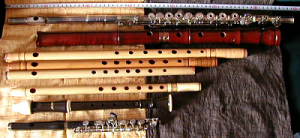The flute is a family of musical instrument of the woodwind group. Unlike woodwind instruments with reeds, a flute is an aerophone or reedless wind instrument that produces its sound from the flow of air across an opening. According to the instrument classification of Hornbostel Sachs, flutes are categorized as edge blown aerophones.
A musician who plays the flute can be referred to as a flute player, a flautist,a flutist or less commonly a fluter. The term flutenist, found in English up to the 18th century, is now virtually obsolete.
A flute produces sound when a stream of air directed across a hole in the instrument creates a vibration of air at the hole. The air stream across this hole creates a siphon.This excites the air contained in the usually cylindrical resonant cavity within the flute. The player changes the pitch of the sound produced by opening and closing holes in the body of the instrument, thus changing the effective length of the resonator and its corresponding resonant frequency. By varying the air pressure, a flute player can also change the pitch of a note by causing the air in the flute to resonate at a harmonic rather than the fundamental frequency without opening or closing any holes.
To be louder, a flute must use a larger resonator, a larger air stream, or increased air stream velocity. A flute’s volume can generally be increased by making its resonator and tone holes larger. This is why a police whistle, a form of flute, is very wide for its pitch, and why a pipe organ can be far louder than a concert flute: a large organ pipe can contain several cubic feet of air, and its tone hole may be several inches wide, while a concert flute’s air stream measures a fraction of an inch across.
The air stream must be directed at the correct angle and velocity, or else the air in the flute will not vibrate. In fippled or ducted flutes, a precisely formed and placed windway will compress and channel the air to the labium ramp edge across the open window. In the pipe organ, this air is supplied by a regulated blower. In non-fipple flutes, the air stream is shaped and directed by the player’s lips, called the embouchure. This allows the player a wide range of expression in pitch, volume, and timbre, especially in comparison to fipple/ducted flutes. However, it also makes an end blown flute or transverse flute considerably more difficult for a beginner to produce a full sound on than a ducted flute, such as the recorder. Transverse and end-blown flutes also take more air to play, which requires deeper breathing and makes circular breathing a considerably trickier proposition.
Generally, the quality called timbre or “tone colour” varies because the flute can produce harmonics in different proportions or intensities. The tone color can be modified by changing the internal shape of the bore, such as the conical taper, or the diameter to length ratio. A harmonic is a frequency that is a whole number multiple of a lower register, or “fundamental” note of the flute. Generally the air stream is thinner (vibrating in more modes), faster (providing more energy to excite the air’s resonance), and aimed across the hole less deeply (permitting a more shallow deflection of the air stream) in the production of higher harmonics or upper partials.
Head joint geometry appears particularly critical to acoustic performance and tone, but there is no clear consensus on a particular shape amongst manufacturers. Acoustic impedance of the embouchure hole appears the most critical parameter. Critical variables affecting this acoustic impedance include: chimney length (hole between lip-plate and head tube), chimney diameter, and radii or curvature of the ends of the chimney and any designed restriction in the “throat” of the instrument, such as that in the Japanese Nohkan Flute.
Aside from the voice, flutes are the earliest known musical instruments. A number of flutes dating to about 43,000 to 35,000 years ago have been found in the Swabian Alb region of Germany. These flutes demonstrate that a developed musical tradition existed from the earliest period of modern human presence in Europe.
